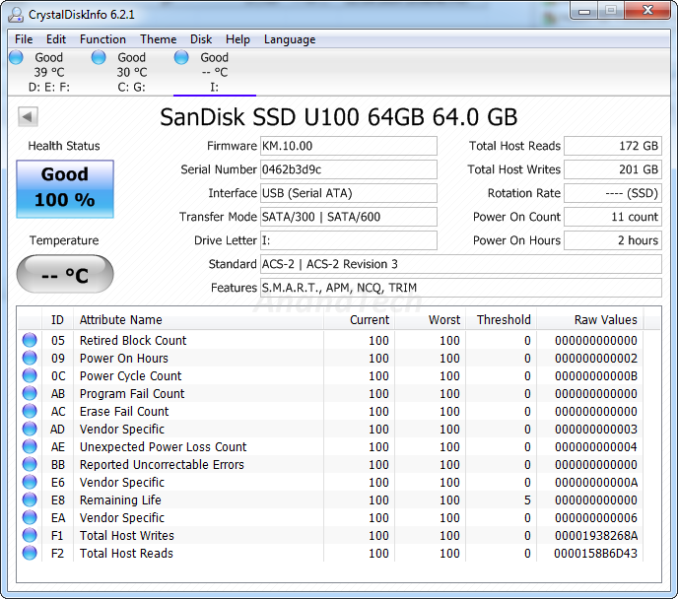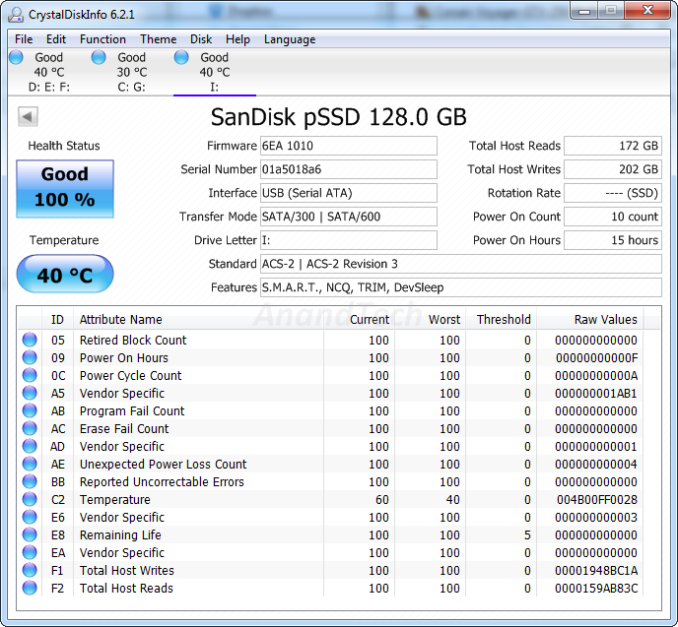
Original Link: https://www.anandtech.com/show/8755/sandisk-extreme-pro-usb-30-flash-drive-capsule-review
SanDisk Extreme PRO USB 3.0 Flash Drive Capsule Review
by Ganesh T S on November 27, 2014 7:00 PM EST- Posted in
- Storage
- USB 3.0
- Flash Drive
- SanDisk
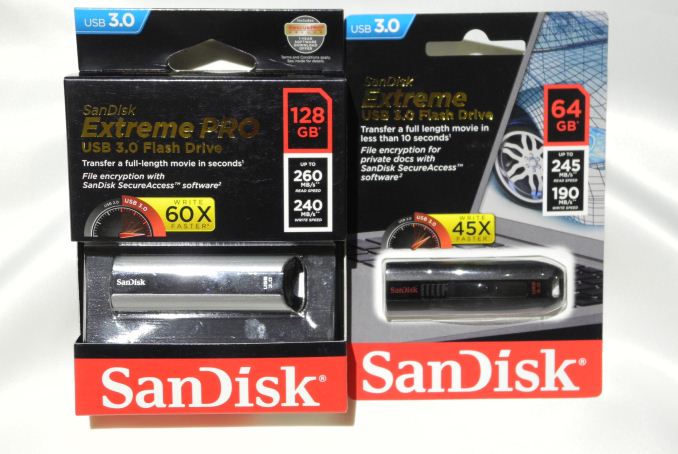
Introduction and Testing Methodology
The last few years have seen rapid advancements in flash technology and the rise of USB 3.0 as an ubiquitous high-speed interface on computers. These have led to the appearance of small and affordable direct attached storage units with very high performance for day-to-day data transfer applications. We have already looked at some flash drives with SSD controllers and a USB 3.0 - SATA bridge over the last couple of months. These include the Corsair Flash Voyager GTX 256GB using the Phison S9 controller and the Mushkin Ventura Ultra using the SandForce SF2281 controller respectively.
Today, we will be looking at what SanDisk brings to the market with the Extreme and Extreme PRO lineups. Unlike the other units we have looked at previously, these two don't use a USB 3.0 - SATA bridge, since the internal controller is native USB 3.0 and not a repurposed SATA SSD controller. CrystalDiskInfo gives us some insights into the units.
The SanDisk Extreme 64GB seems to be based on the U100 SSD with a SATA - USB 3.0 bridge. Even though TRIM is reported as supported, we were unable to get it to work through the bridge configuration. The information provided for the Extreme PRO, however, seems to be a bit off. The unit is definitely not a pSSD. Both sets of information need to be takn with a pinch of salt.
The Extreme unit comes with a maximum capacity of 64 GB, while the Extreme PRO update which came in earlier this year has a maximum capacity of 128 GB.
Both lineups use a retractable USB 3.0 connector. They come with a 1-year license for LC Technology's RescuePRO Deluxe data recovery software. Another important differentiation aspect is SanDisk's SecureAccess software that allows for creation of encrypted folders within the flash drive. It uses AES and is quite secure, but forum posts suggest that it is not very reliable. Additionally, the encryption is done in software. Performance would vary with the capabilities of the host system. Given these aspects, we don't believe it is worth the trouble and/or risk to utilize this feature. Users requiring encrypted flash drives are advised to look for ones with hardware encryption (which cost quite a bit more for the same capacity, though).
Testbed Setup and Testing Methodology
Evaluation of DAS units on Windows is done with the testbed outlined in the table below. For devices with USB 3.0 connections (such as the SanDisk units we are considering today), we utilize the USB 3.0 port directly hanging off the PCH.
| AnandTech DAS Testbed Configuration | |
| Motherboard | Asus Z97-PRO Wi-Fi ac ATX |
| CPU | Intel Core i7-4790 |
| Memory | Corsair Vengeance Pro CMY32GX3M4A2133C11 32 GB (4x 8GB) DDR3-2133 @ 11-11-11-27 |
| OS Drive | Seagate 600 Pro 400 GB |
| Optical Drive | Asus BW-16D1HT 16x Blu-ray Write (w/ M-Disc Support) |
| Add-on Card | Asus Thunderbolt EX II |
| Chassis | Corsair Air 540 |
| PSU | Corsair AX760i 760 W |
| OS | Windows 8.1 Pro |
| Thanks to Asus and Corsair for the build components | |
The full details of the reasoning behind choosing the above build components can be found here.
The list of DAS units used for comparison purposes in the rest of the review is provided below.
- SanDisk Extreme PRO 128GB
- SanDisk Extreme 64GB
- Corsair Voyager GTX 256GB
- LaCie Rugged Thunderbolt 500GB
- Mushkin Atom 64GB
- Mushkin Ventura Ultra 120GB
- VisionTek Pocket SSD 240GB
Storage Benchmarks
Synthetic Benchmarks - ATTO and Crystal DiskMark
SanDisk claims read/write speeds of 245 MBps/190 MBps and 260 MBps/240 MBps respectively for the Extreme and Extreme PRO. These are backed up by the ATTO benchmarks provided below. Unfortunately, these access traces are not very common in real-life scenarios.
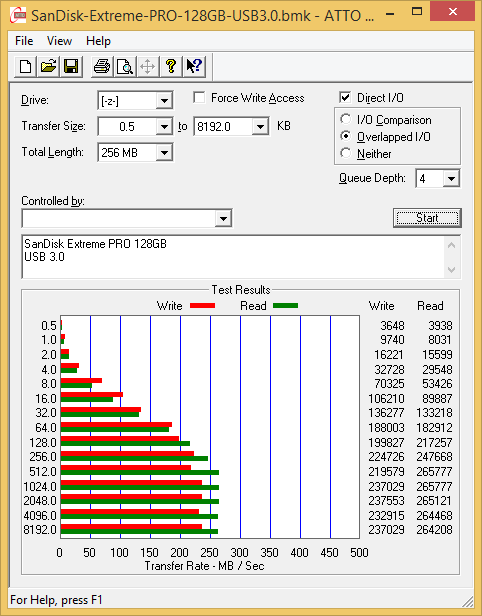
CrystalDiskMark, despite being a canned benchmark, provides a better estimate of the performance range with a selected set of numbers. As evident from the screenshot below, the performance can dip to as low as 8.7 MBps for 4K read accesses at QD32. However, these types of accesses are not common for the large size file transfers that form the primary use-case for the Extreme and Extreme PRO.
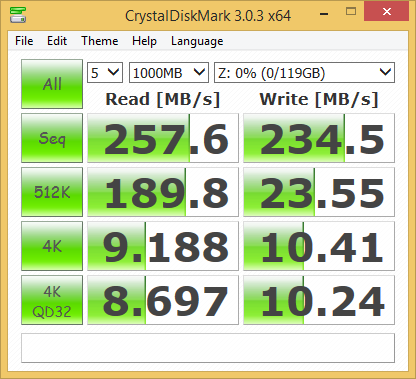
Real-Life Benchmarks - robocopy and PCMark 8 Storage Bench
Our testing methodology for DAS units also takes into consideration the usual use-case for such devices. The most common usage scenario is transfer of large amounts of photos and videos to and from the unit. The minor usage scenario is importing files directly off the DAS into a multimedia editing program such as Adobe Photoshop.
In order to tackle the first use-case, we created three test folders with the following characteristics:
- Photos: 15.6 GB collection of 4320 photos (RAW as well as JPEGs) in 61 sub-folders
- Videos: 16.1 GB collection of 244 videos (MP4 as well as MOVs) in 6 sub-folders
- BR: 10.7 GB Blu-ray folder structure of the IDT Benchmark Blu-ray (the same that we use in our robocopy tests for NAS systems)
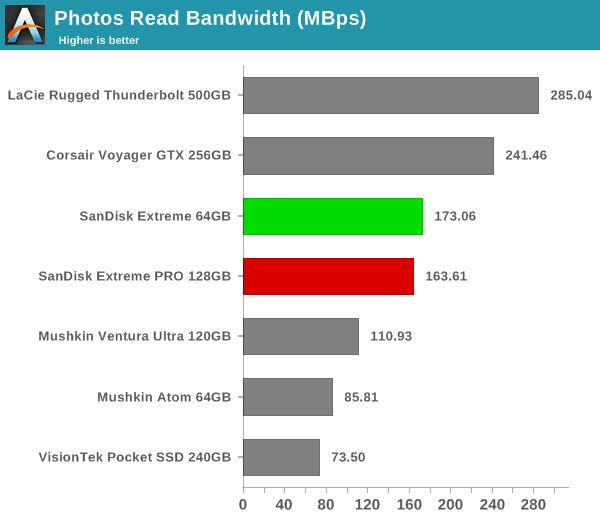
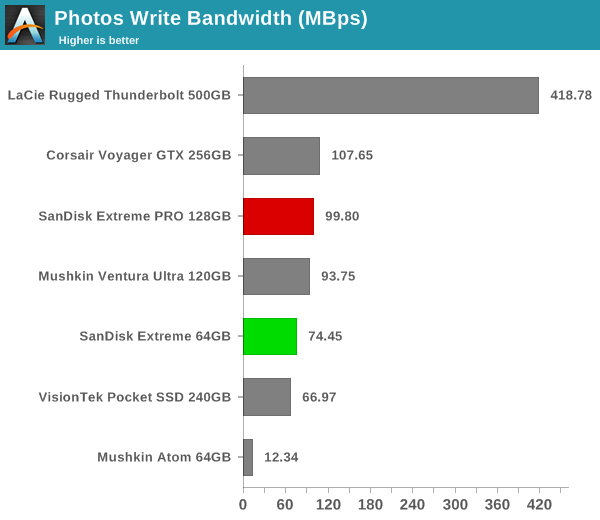
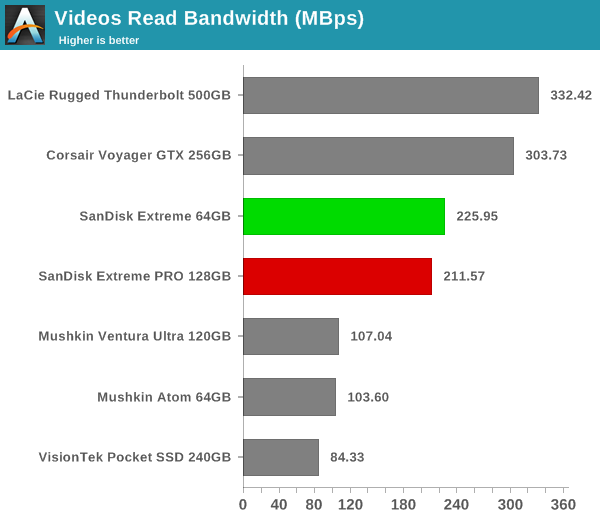
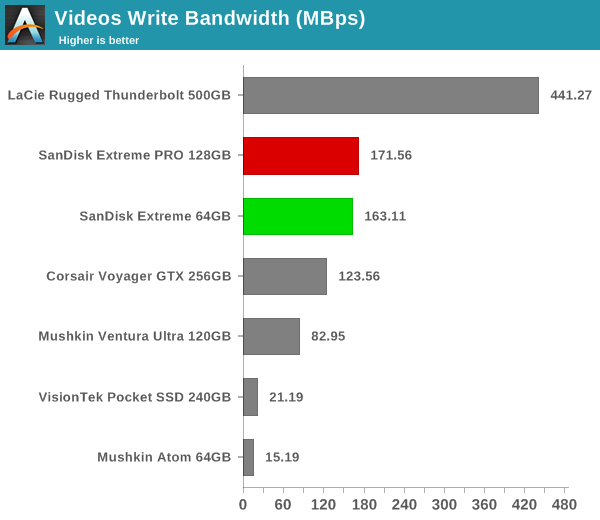
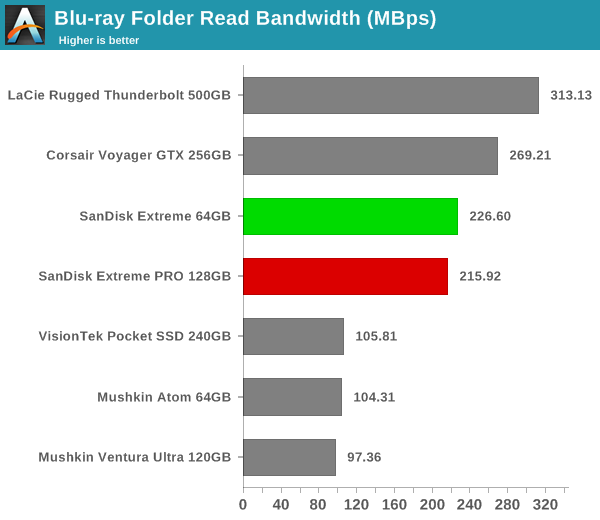
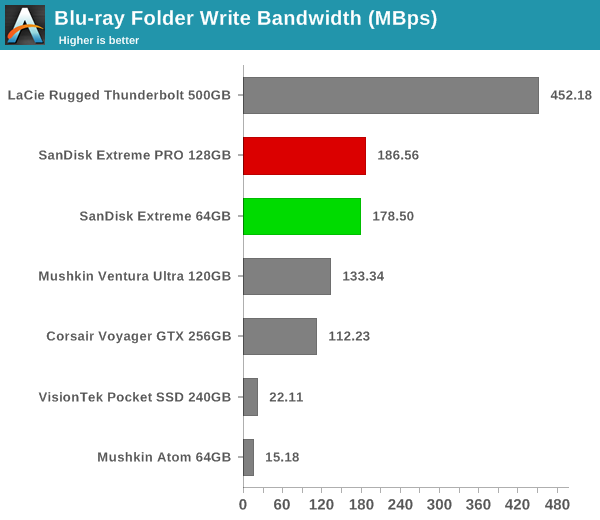
The general trend we observed was that the SanDisk Extreme was better at read benchmarks (though the Extreme PRO was quite close). When it came to the writes, the Extreme PRO pulled ahead (sometimes by as much as 25 MBps for lots of small files).
For the second use-case, we take advantage of PC Mark 8's storage bench. The storage workload involves games as well as multimedia editing applications. The command line version allows us to cherry-pick storage traces to run on a target drive. We chose the following traces.
- Adobe Photoshop (Light)
- Adobe Photoshop (Heavy)
- Adobe After Effects
- Adobe Illustrator
Usually, PC Mark 8 reports time to complete the trace, but the detailed log report has the read and write bandwidth figures which we present in our performance graphs. Note that the bandwidth number reported in the results don't involve idle time compression. Results might appear low, but that is part of the workload characteristic. Note that the same testbed is being used for all DAS units. Therefore, comparing the numbers for each trace should be possible across different DAS units.
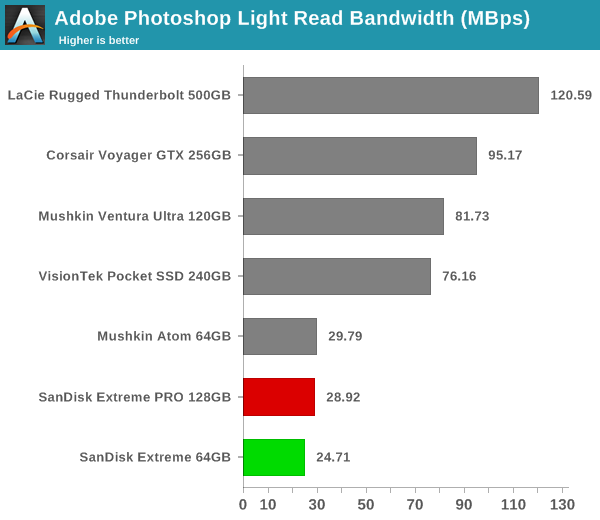
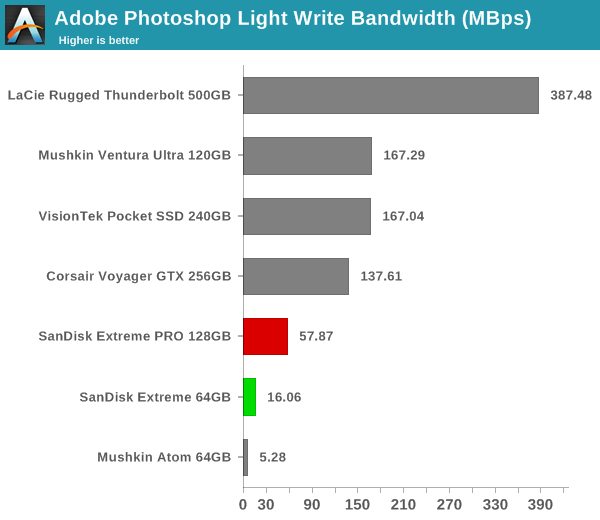
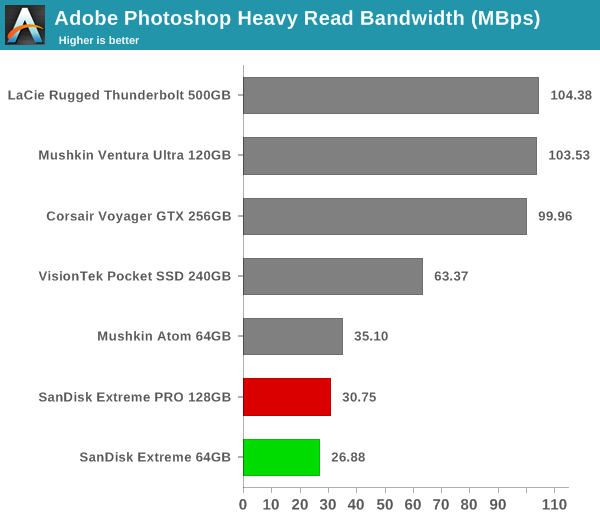
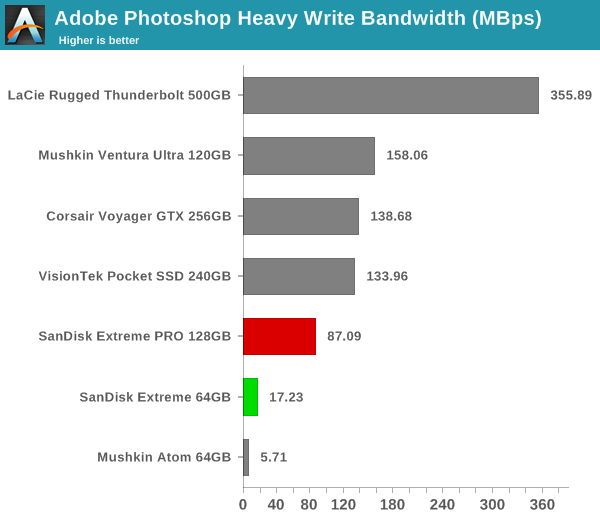
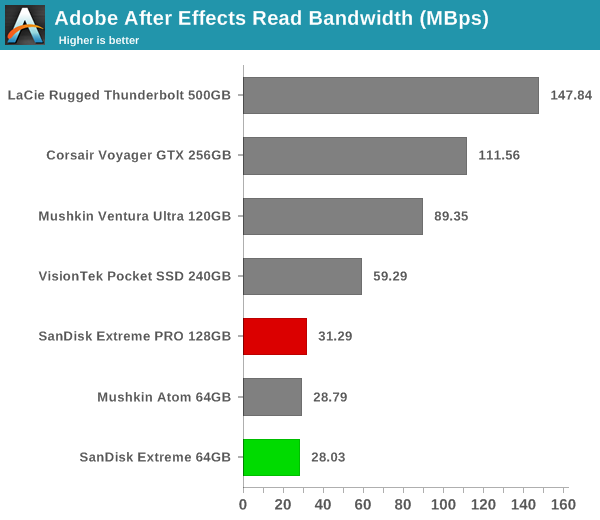
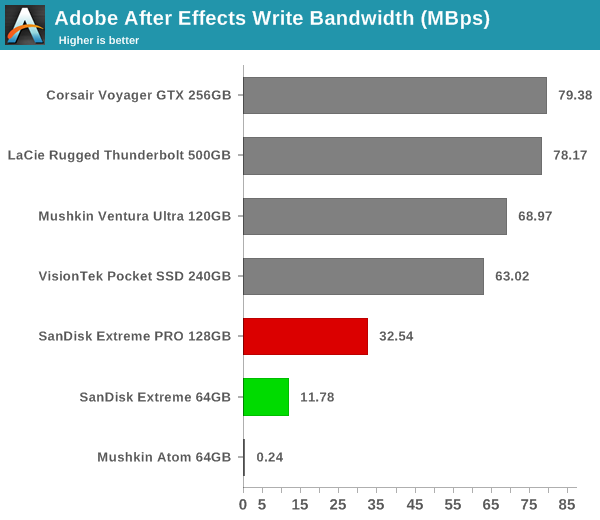
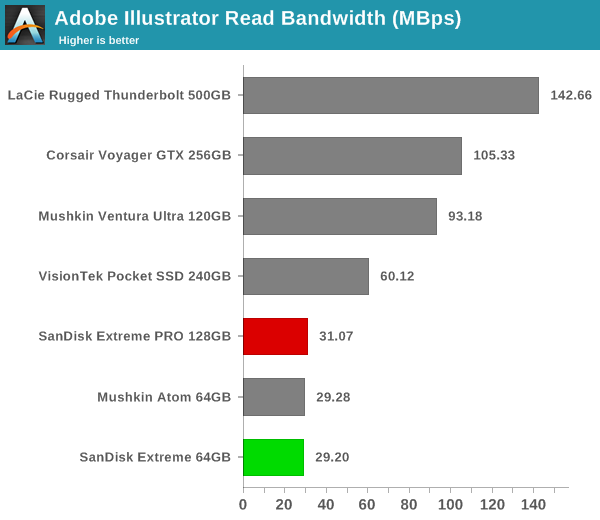
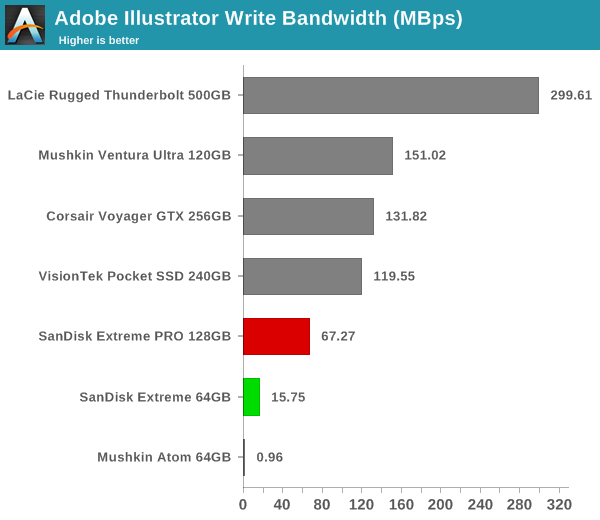
The workload traces from PCMark 8's storage bench are meant to evaluate SSDs (which is the reason the drives based on SSD controllers give great results). The firmwares in the SanDisk units being evaluated today are not optimized for these types of accesses. We wouldn't read much into the standings of the SanDisk units in the above graphs, except for the fact that one shouldn't try editing multimedia files directly off them.
Performance Consistency and Concluding Remarks
Yet another interesting aspect of these types of units is performance consistency. Aspects that may influence this include thermal throttling and firmware caps on access rates to avoid overheating or other similar scenarios. This aspect is an important one, as the last thing that users want to see when copying over, say, 100 GB of data to the flash drive, is the transfer rate going to USB 2.0 speeds. In order to identify whether the drive under test suffers from this problem, we instrumented our robocopy DAS benchmark suite to record the flash drive's read and write transfer rates while the robocopy process took place in the background. For supported drives, we also recorded the internal temperature of the drive during the process. The graphs below show the speeds observed during our real-world DAS suite processing. The first three sets of writes and reads correspond to the photos suite. A small gap (for the transfer of the videos suite from the primary drive to the RAM drive) is followed by three sets for the next data set. Another small RAM-drive transfer gap is followed by three sets for the Blu-ray folder.
An important point to note here is that each of the first three blue and green areas correspond to 15.6 GB of writes and reads respectively. Throttling, if any, is apparent within the processing of the photos suite itself. We found that the Extreme PRO unit exposed the internal controller temperature to the host OS, while the Extreme didn't. That said, neither the Extreme PRO, nor the Extreme throttled under these heavy loading conditions (a total of 127 GB of writes and 127 GB of reads within a 30 minute duration).
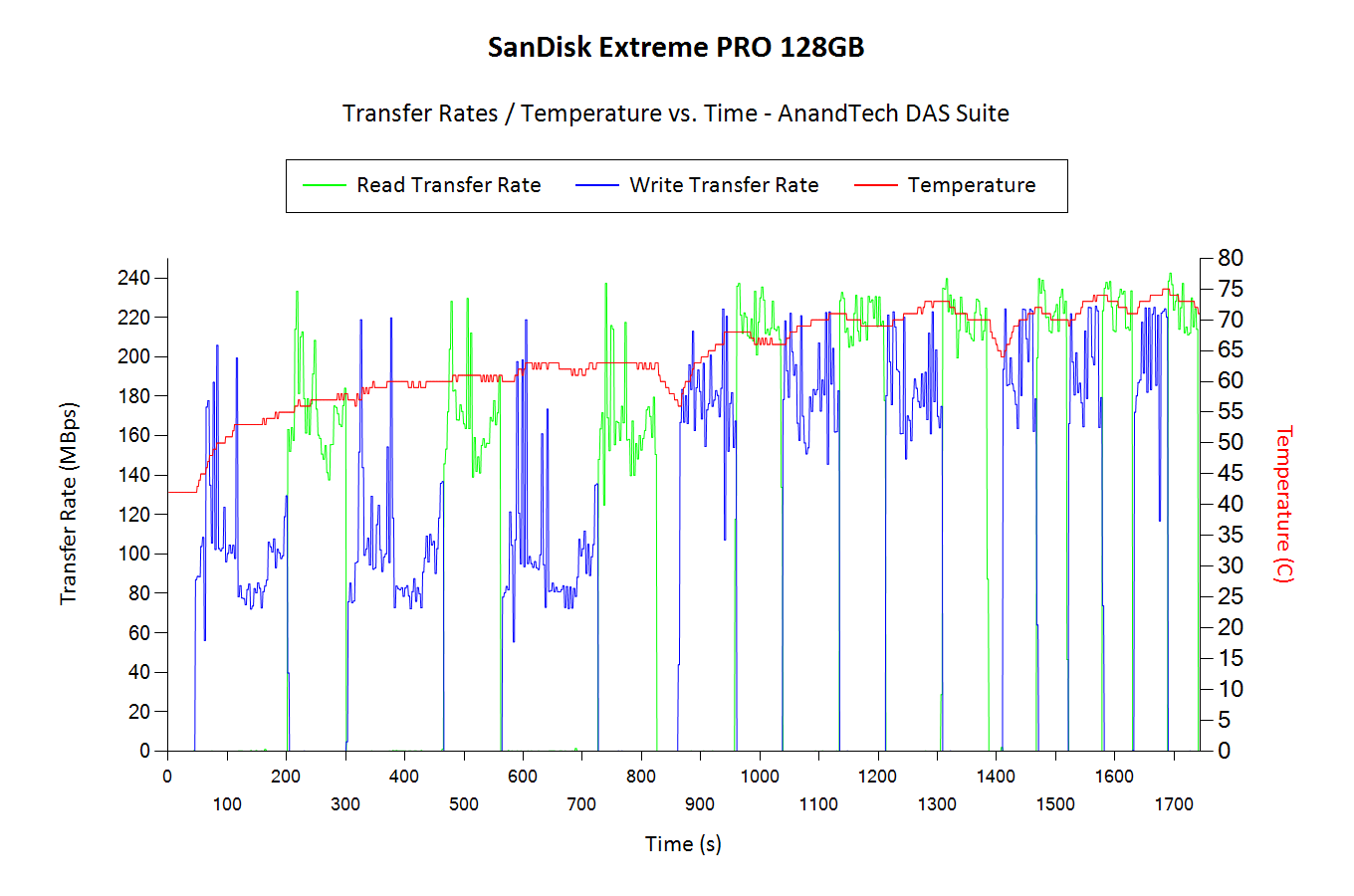
The Extreme PRO internal temperatures do seem to rise rapidly with heavy writes (reaching as much as 75 C at the end of our test routine). However, the cooling down during the short idle period (RAM drive transfer gap) seems to be fast, indicative of good thermal design. Internally, the Extreme PRO idled around 43 C.
Concluding Remarks
Coming to the business end of the review, the Extreme and Extreme PRO USB 3.0 drives continue SanDisk's tradition of improving the performance of their USB 3.0 flash drive every generation. The performance of the drives leave us with no doubt that they have been tailored to fit the traditional flash drive use-cases. It must be made clear that the Extreme and Extreme PRO are not candidates to consider for a portable OS or Windows-To-Go drive.
Since there is no TRIM support through the SATA - USB bridge, users are advised to format them in a file system suitable for flash drives (such as exFAT). The final aspect we consider today is the cost.
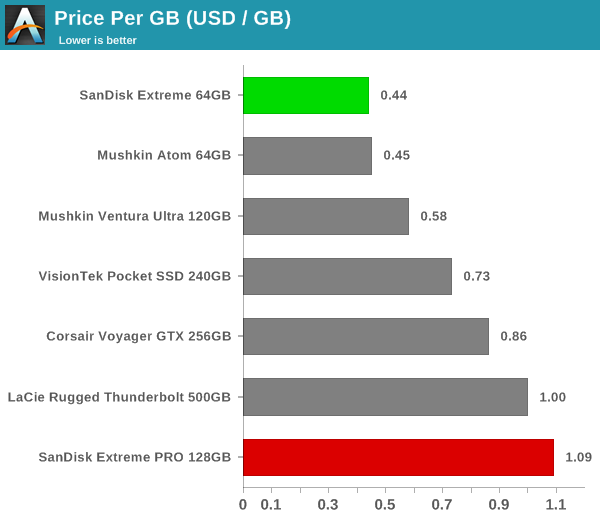
While the $28 SanDisk Extreme 64 GB is a no-brainer as a stocking stuffer or impulse buy, the $138 SanDisk Extreme PRO 128 GB is a bit more difficult to recommend (considering its price per GB). The write performance of the Extreme PRO is better than the Corsair Voyager GTX for large files, but the Voyager GTX manages better performance over-all (even for typical flash drive use-cases). Obviously, the caveat here is that we tested the 256 GB variant of the Voyager GTX, while the Extreme PRO tops out at 128 GB. All said, the performance that SanDisk has managed to put in a typical flash drive form factor is impressive. We look forward to the price per GB metric of the Extreme PRO being improved and larger capacities coming to the market.

